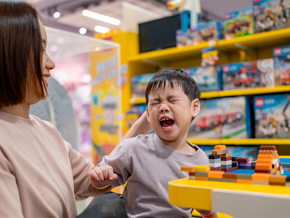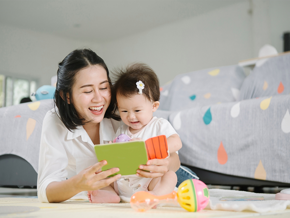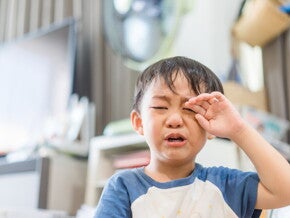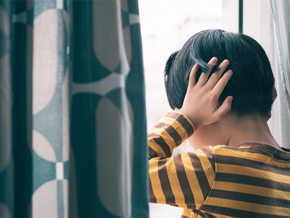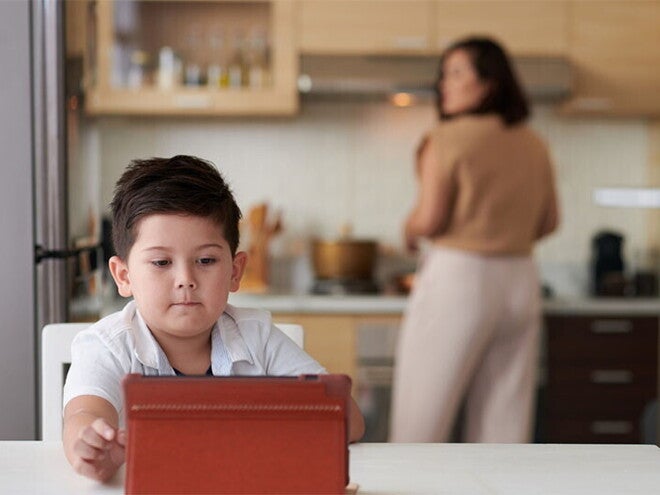
Is My Child a Gadget Addict? What a Pediatrician Wants You to Know
It starts innocently. You hand your child a tablet to keep them busy while you finish a chore. Soon, you notice asking them to put it away triggers a meltdown. This leaves you wondering, "Is my child becoming a gadget addict?"
This guide will help you identify those signs of dependency, understand the impact on your child's social and emotional development, and create a healthier digital life at home.
Warning Signs of a Gadget Addict
The nature of today's technology is one reason why screen time has become a concern. "Now, gadgets and shows are very interactive," pediatrician Dr. Katrina Florcruz explains during an "Ask Me Anything" session with the ParenTeam Moms and Dads Facebook Group.
"Kids can swipe, click, scroll, choose content, and switch apps quickly. Kids are exposed to algorithm-driven content (YouTube, TikTok, games), which can be addictive and sometimes inappropriate."
A child with gadget addiction shows a compulsive need for their device. Here are specific cues to watch out for:
1. They show withdrawal symptoms.
The most obvious sign is their emotional reaction. When you take the gadget away, does your child become extremely irritable, anxious, or moody? Tantrums when screen time ends are a sign that your child is using gadgets too often, says Dr. Florcruz.
Another red flag, she adds, is when "hinahanap ang gadgets pagkagising o habang kumakain." This shows that they're so used to the constant fun and stimulation from the screen, making everyday quiet moments feel empty or boring.
2. They lose interest in other forms of play.
A sudden loss of interest in toys and outdoor play is another concern, Dr. Florcruz explains.
Toddlers and preschoolers (ages 3 to 5) might refuse to play with their toys, ignore picture books, or show no interest in creative activities like drawing.
For school-age kids, this can extend to ignoring homework assignments, forgetting chores, or choosing screens over spending time with friends.
3. Older kids become deceptive about their gadget use.
As children get older and are more independent, you might notice more secretive behavior. You could catch them using their device after bedtime or when they’re supposed to be studying. When asked, they might even lie about how long they’ve been online.
How Excessive Screen Time Affects Your Child

The blue light from screens can disrupt melatonin production, making it harder for kids to get the sleep they need.
The World Health Organization (WHO) recommends no screen time at all for children under 2 and no more than one hour a day for children aged 2 to 5, always with a parent or caregiver present. For older kids, it’s less about hitting a time limit and more about balancing screen time with sleep, schoolwork, and unstructured play.
Excessive gadget exposure can impact your child’s physical health, learning, and behavior in the following ways:
Disrupted sleep
According to the Sleep Foundation, blue light from screens disrupts sleep by blocking melatonin, the hormone that helps your child feel sleepy. This makes it harder for them to get the quality rest needed for focus, good mood, and overall health.
Slower learning and behavioral issues
A 2023 review in Multimodal Technologies and Interaction suggests that too much screen time from infancy through age 7 can make it harder for kids to focus and learn. It also increases stress, anxiety, and other behavioral problems.
The American Psychological Association (APA) explains that excessive screen time can create a vicious cycle. Constant digital engagement can lead to behavioral issues like anxiety, depression, aggression, and hyperactivity. Children experiencing these feelings often turn to devices even more to cope.
So, it's essential to balance screen use with other activities like playing outside, reading, and creative projects.
Physical health problems
Hours spent hunched over a device can also lead to “text neck,” according to a 2021 study on children and adolescents aged 8 and 18. More importantly, this habit promotes a sedentary lifestyle, which can contribute to weight gain and other long-term health issues.
Effects on vision
Can early phone use worsen a child's eyesight? "Yes," confirms Dr. Florcruz. "Too much screen time, especially using cellphones with smaller screens, can put the child at risk for eye problems like nearsightedness."
She advises following the 20-20-20 rule: every 20 minutes, look at something 20 feet away for 20 seconds or encourage outdoor play and gadget-free activities.
Are Your Habits Fueling Your Child’s Gadget Use?
Sometimes, your actions can unintentionally encourage gadget dependency.
You’re using devices as digital pacifiers.
It's tempting to use a smartphone to quiet a fussy child in a restaurant or during errands. While effective in the short term, a 2023 study in JAMA Pediatrics suggests this could backfire.
Using devices to calm children ages 3 to 5 often leads to greater emotional reactivity later on, likely because the habit prevents them from learning to self-soothe.
You have different rules for adults and kids.
You might tell your kids to put their phones away at the dinner table while you scroll through yours. Children learn from what you do, not just what you say. Modeling healthy digital habits is essential if you want to limit screen time.
Screen-Free Activities Your Kids Will Enjoy

Encouraging outdoor play helps children develop social skills and physical health away from screens.
"Kids now are what we call 'digital natives,'" says Dr. Florcruz. "It's possible to raise them without screens, but the reality is it might take a bit more effort and might not be very practical since many aspects of the way we live [are] also anchored on digital technology." The goal is balance.
If you’re looking for screen-free fun, here are some ideas to get you started:
Outdoor play
WHO’s official guidelines recommend that preschoolers (ages 3 to 4) engage in at least 180 minutes of physical activity per day, with at least 60 minutes of that time spent on energetic play.
So head outside for a bike ride, visit a park, or teach your kids the games you played as a child, like patintero or sipa. This kind of active play is not only fantastic for their physical health but also creates lasting memories that no app can replicate.
Board games
Declare one night a week as the official family game night. Bring out classic board games, a deck of cards, or even charades. Check out these fun family activities for more ideas. The goal is friendly competition and laughter.
Arts, crafts, and kitchen creations
Build a pillow fort in the living room, bring out art supplies for a painting session, or bake a simple recipe together. The joy comes from the shared experience of creating something together.
Setting Healthy Digital Limits as a Family
Setting healthy limits isn't about declaring war on gadgets. The goal is to teach your child balance. As the World Economic Forum suggests, it’s less about an outdoor play versus screen time divide and more about making sure your child enjoys the best of both worlds: high-quality digital content and plenty of essential, active play.
1. Set clear rules and boundaries.
Work with your child to establish rules for gadget use. Define tech-free times (like during meals and an hour before bedtime) and tech-free zones (like bedrooms). When the rules are known ahead of time, there are fewer arguments later.
2. Plan the "time's up" transition.
The toughest part is often ending screen time without a meltdown. "This is very common, especially if they are cut off from what they're watching," Dr. Florcruz sympathizes. She suggests two tips to avoid tantrums:
- Using a timer: "Whenever my yaya is co-viewing a video with my toddler, I remind her na three or four songs lang, then pause the TV first before turning it off."
- Having the next activity ready: "You can say to your child, after two songs, we will eat merienda, or go out and take a walk, or play with our pet dog."
3. Talk about the "why."
Instead of just laying down the law, explain why you need to limit screen time. Talk about the importance of sleep for growing, play for learning, and conversation for family bonding. When your child understands your reasons, they’re more likely to get on board.
Don’t forget peer pressure! When your child feels left out, Dr. Florcruz advises you to listen and validate their feelings. Then calmly explain the "why" behind your family's rules. "Help them understand that you are not depriving them but teaching them to utilize technology and these gadgets responsibly and in a healthy way."
4. Apply special rules for kids under 2.
While WHO’s official guideline is zero screen time for children under 2, many parents find this unrealistic, explains Dr. Florcruz. If you must use screens, stick to video calls with family or short periods of parent-guided viewing, she advises. The content must be high-quality, educational, and slow-paced.
By taking these steps, you can address the behaviors of a gadget addict and guide your child toward a healthier, more balanced relationship with technology.
Join the ParenTeam Moms and Dads Facebook group and share your tips on how to help a child who may be a gadget addict.
References
American Optometric Association. "New WHO Guidance: Very Limited Daily Screen Time Recommended for Children Under 5." May 6, 2019. Accessed June 11, 2025. https://www.aoa.org/news/clinical-eye-care/public-health/screen-time-for-children-under-5.
American Academy of Child and Adolescent Psychiatry. "Screen Time and Children." Facts for Families, no. 54. Updated May 2024. https://www.aacap.org/AACAP/Families_and_Youth/Facts_for_Families/FFF-Guide/Children-And-Watching-TV-054.aspx.
Devi, K. A., and S. K. Singh. 2023. "The Hazards of Excessive Screen Time: Impacts on Physical Health, Mental Health, and Overall Well-Being." Journal of Education and Health Promotion 12: 413. Accessed June 11, 2025. https://doi.org/10.4103/jehp.jehp_447_23.
Ho, Shu Nga Janice, Mong-Lin Yu, and Ted Brown. "The Relationship Between Children’s Screen Time and the Time They Spend Engaging in Play: An Exploratory Study." Journal of Occupational Therapy, Schools, & Early Intervention17, no. 4 (2024): 903-22. Published online March 26, 2024. Accessed June 11, 2025. https://doi.org/10.1080/19411243.2024.2333276.
Mayo Clinic. "Screen Time and Children: How to Guide Your Child." June 19, 2024. Accessed June 11, 2025. https://www.mayoclinic.org/healthy-lifestyle/childrens-health/in-depth/screen-time/art-20047952.
McArthur, B. A., V. Volkova, S. Tomopoulos, and S. Madigan. 2022. "Global Prevalence of Meeting Screen Time Guidelines Among Children 5 Years and Younger: A Systematic Review and Meta-analysis." JAMA Pediatrics 176, no. 4 (April): 373–83. Accessed June 11, 2025. https://doi.org/10.1001/jamapediatrics.2021.6386.
Nemours KidsHealth. "Media Use Guidelines: Babies & Toddlers." Medically reviewed by Elana Pearl Ben-Joseph. August 2022. Accessed June 11, 2025. https://kidshealth.org/en/parents/screentime-baby-todd.html.
Pappas, Stephanie. "What Do We Really Know About Kids and Screens?" Monitor on Psychology 51, no. 3 (April 2020). Accessed June 11, 2025. https://www.apa.org/monitor/2020/04/cover-kids-screens.
Radesky, Jiska S., Niko Kaciroti, Heather M. Weeks, Alexandra Schaller, and Alison L. Miller. "Longitudinal Associations Between Use of Mobile Devices for Calming and Emotional Reactivity and Executive Functioning in Children Aged 3 to 5 Years." JAMA Pediatrics 177, no. 1 (January 2023): 62–70. Accessed June 11, 2025. https://doi.org/10.1001/jamapediatrics.2022.4793.
Stiglic, N., and R. M. Viner. 2019. "Effects of Screentime on the Health and Well-Being of Children and Adolescents: A Systematic Review of Reviews." BMJ Open 9 (1): e023191. Accessed June 11, 2025. https://doi.org/10.1136/bmjopen-2018-023191.
UNICEF. n.d. "Babies Need Humans, Not Screens." UNICEF Parenting. Accessed June 11, 2025. Accessed June 11, 2025. https://www.unicef.org/parenting/child-development/babies-screen-time.











